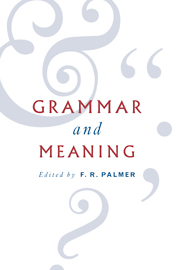Book contents
- Frontmatter
- Contents
- List of contributors
- Foreword
- 1 Polysemous relations
- 2 Fields, networks and vectors
- 3 Syntax, semantics, pragmatics
- 4 Natural-language interpretation as labelled natural deduction
- 5 Three levels of meaning
- 6 Does spoken language have sentences?
- 7 Grammaticalisation and social structure: non-standard conjunction-formation in East Anglian English
- 8 German Perfekt and Präteritum: speculations on meaning and interpretation
- 9 The possessed
- 10 Complement clauses and complementation strategies
- 11 Grammar and meaning
- John Lyons: publications
- Index
8 - German Perfekt and Präteritum: speculations on meaning and interpretation
Published online by Cambridge University Press: 30 January 2010
- Frontmatter
- Contents
- List of contributors
- Foreword
- 1 Polysemous relations
- 2 Fields, networks and vectors
- 3 Syntax, semantics, pragmatics
- 4 Natural-language interpretation as labelled natural deduction
- 5 Three levels of meaning
- 6 Does spoken language have sentences?
- 7 Grammaticalisation and social structure: non-standard conjunction-formation in East Anglian English
- 8 German Perfekt and Präteritum: speculations on meaning and interpretation
- 9 The possessed
- 10 Complement clauses and complementation strategies
- 11 Grammar and meaning
- John Lyons: publications
- Index
Summary
Introduction
In comparison with English, German appears at first sight to have a very simple tense-aspect system, certainly if we restrict the terms tense and aspect to grammatical categories of the languages, whether expressed by synthetic or periphrastic means. German has two simple forms, the Present (as in ich liebe ‘I love’) and a simple past form, which I will henceforth, following German usage, call the Präteritum (as in ich liebte ‘I loved’). In addition, there is a compound past form, as in ich habe geliebt ‘I have loved’, which I will henceforth, following German usage, refer to as the Perfekt. Other periphrastic forms include the Pluperfect (as in ich hatte geliebt ‘I had loved’), the Future (as in ich werde lieben ‘I shall love’) and the Future Perfect (in German conventionally called the Futur II, as in ich werde geliebt haben ‘I will have loved’), although, as in many other languages, the question arises whether the Future and Future Perfect are more properly to be classified as tenses or moods. Some varieties of German also have Double Perfect and Double Pluperfect periphrastic forms, as in ich habe geliebt gehabt and ich hatte geliebt gehabt; English has no corresponding forms. The focus of interest in this article will be the distinction between the Perfekt and the Prateritum, the two major verb forms used with past time reference.
In some varieties of German, the system is even simpler, through loss of the Präteritum, leaving the Perfekt as the only form with past time reference as part of its basic meaning.
- Type
- Chapter
- Information
- Grammar and MeaningEssays in Honour of Sir John Lyons, pp. 148 - 161Publisher: Cambridge University PressPrint publication year: 1995
- 1
- Cited by



